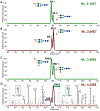Isomeric separation of permethylated glycans by extra-long reversed-phase liquid chromatography (RPLC)-MS/MS
- PMID: 35311852
- PMCID: PMC9117491
- DOI: 10.1039/d2an00010e
Isomeric separation of permethylated glycans by extra-long reversed-phase liquid chromatography (RPLC)-MS/MS
Abstract
Glycosylation is known as a critical biological process that can largely affect the properties and the functions of proteins. Glycan isomers have been shown to be involved in a variety of disease progressions. However, the separation and identification of glycan isomers has been a challenge for years due to the microheterogeneity of glycan isomeric structures. Therefore, effective and stable techniques have been investigated over the last few decades to improve isomeric separations of glycans. RPLC has been widely used in biomolecule analysis because of its extraordinary reproducibility and reliability in retention time and separation resolution. However, so far, no studies have achieved high resolution of glycan isomers using this technique. In this study, we focused on further boosting the isomeric separation of permethylated glycans using a 500 mm reversed-phase LC column. To achieve better resolutions on permethylated glycans, different LC conditions were optimized using glycan standards, including core- and branch-fucosylated N-glycan isomers and sialic acid linked isomers, which were both successfully separated. Then, the optimal separation strategy was applied to achieve separations of N- and O-glycan isomers derived from model glycoproteins, including bovine fetuin, ribonuclease B and κ-casein. Baseline separations were observed on multiple sialylated linkage isomers. However, the separation performance of high-mannose isomers needs further improvement. The reproducibility and stability of this long C18 column was also tested by doing run-to-run, day-to-day and month-to-month comparisons of retention times on multiple glycans and the %RSD was found less than 0.92%. Finally, we applied this approach to separate glycan isomers derived from complex biological samples, including blood serum and cell lines, where baseline separations were attained on several isomeric structures. Compared to the separation efficiency of PGC and MGC columns, the RPLC C18 column provides lower resolution but more robust reproducibility, which makes it a good complementary alternative for isomeric separations of glycans.
Conflict of interest statement
Conflict of interest
The authors declare no competing financial interest.
Figures

 , N-acetylglucosamine (GlcNAc);
, N-acetylglucosamine (GlcNAc);  , Galactose (Gal);
, Galactose (Gal);  , Fucose (Fuc);
, Fucose (Fuc);  , Mannose (Man);
, Mannose (Man);  , Glucose (Glc);
, Glucose (Glc);  , N-acetylneuraminic acid (NeuAc/Sialic Acid).
, N-acetylneuraminic acid (NeuAc/Sialic Acid).




Similar articles
-
LC-MS/MS isomeric profiling of permethylated N-glycans derived from serum haptoglobin of hepatocellular carcinoma (HCC) and cirrhotic patients.Electrophoresis. 2017 Sep;38(17):2160-2167. doi: 10.1002/elps.201700025. Epub 2017 Jul 14. Electrophoresis. 2017. PMID: 28543513 Free PMC article.
-
Isomeric Separation of Permethylated Glycans by Porous Graphitic Carbon (PGC)-LC-MS/MS at High Temperatures.Anal Chem. 2017 Jun 20;89(12):6590-6597. doi: 10.1021/acs.analchem.7b00747. Epub 2017 Jun 6. Anal Chem. 2017. PMID: 28475308 Free PMC article.
-
LC-MS/MS of isomeric N-and O-glycopeptides on mesoporous graphitized carbon column.Anal Chim Acta. 2024 Aug 15;1317:342907. doi: 10.1016/j.aca.2024.342907. Epub 2024 Jun 25. Anal Chim Acta. 2024. PMID: 39030008 Free PMC article.
-
Characterization of isomeric glycan structures by LC-MS/MS.Electrophoresis. 2017 Sep;38(17):2100-2114. doi: 10.1002/elps.201700042. Epub 2017 May 17. Electrophoresis. 2017. PMID: 28370073 Free PMC article. Review.
-
MS-based glycomics and glycoproteomics methods enabling isomeric characterization.Mass Spectrom Rev. 2023 Mar;42(2):577-616. doi: 10.1002/mas.21713. Epub 2021 Jun 22. Mass Spectrom Rev. 2023. PMID: 34159615 Free PMC article. Review.
Cited by
-
Glycomics of cervicovaginal fluid from women at risk of preterm birth reveals immuno-regulatory epitopes that are hallmarks of cancer and viral glycosylation.Sci Rep. 2024 Sep 6;14(1):20813. doi: 10.1038/s41598-024-71950-x. Sci Rep. 2024. PMID: 39242814 Free PMC article.
-
An Efficient and Economical N-Glycome Sample Preparation Using Acetone Precipitation.Metabolites. 2022 Dec 17;12(12):1285. doi: 10.3390/metabo12121285. Metabolites. 2022. PMID: 36557323 Free PMC article.
-
Mass spectrometry based biomarkers for early detection of HCC using a glycoproteomic approach.Adv Cancer Res. 2023;157:23-56. doi: 10.1016/bs.acr.2022.07.005. Epub 2022 Sep 6. Adv Cancer Res. 2023. PMID: 36725111 Free PMC article. Review.
-
Serum N-Glycan Profiling of Patients with Narcolepsy Type 1 Using LC-MS/MS.ACS Omega. 2024 Jul 16;9(30):32628-32638. doi: 10.1021/acsomega.4c01593. eCollection 2024 Jul 30. ACS Omega. 2024. PMID: 39100283 Free PMC article.
-
LC-MS/MS Isomeric Profiling of N-Glycans Derived from Low-Abundant Serum Glycoproteins in Mild Cognitive Impairment Patients.Biomolecules. 2022 Nov 8;12(11):1657. doi: 10.3390/biom12111657. Biomolecules. 2022. PMID: 36359007 Free PMC article.
References
MeSH terms
Substances
Grants and funding
LinkOut - more resources
Full Text Sources

